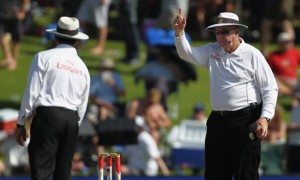
A gradual but inevitable descent into cricket-based loathing and bile.
A Hard Day’s Night
It has recently come to our attention – via the increasingly rubbish Cricinfo – that Australia and New Zealand are probably going to play a day/night Test match towards the end of 2015. Obviously to cricket purists like us, this fills us with dread. Cricket should be played in cream-coloured whites; the ball should be red. Isn’t this kind of frivolous attention-seeking the same kind of farce as the introduction of T20? And before that One-Day Internationals? What are these players wearing helmets for anyway? And why did they start bowling overarm in the first place?
Yeah, purists: up yours. You know what? Day/night Test cricket could actually work. It might need a different set of regulations to ‘normal’ Test cricket, which could cause problems for statistic geeks (like one Nichael Bluth of this parish), but in principle it could be fantastic. Especially for people like us who love our real jobs and don’t like taking annual leave / get too pissed if they start drinking at 11am (delete as appropriate).
But what about the dew, we hear you squeal. Well what about it? It’s a factor in most 50-over day/night matches and it’s never caused too many problems. It’s something that the teams have to take into account, just like the condition of the pitch, the weather and what time last orders are down the local ‘spoons. In an ODI, the side fielding second are most likely to be affected by dew (wet balls for example), but the captains are aware of this at the toss. Therefore, if anything, it is in a one-day game when it is most pertinent. Over the course of five evenings, one would imagine there is more chance of its impact being balanced out (it would be a weird Test match in which the same team is bowling towards the end of each day).
The other, possibly main, issue is the ball. Pink balls have been trialled for around five years now, and there is still considerable distrust of them. Apparently (and we nicked this from the Guardian’s Spin column) they stop swinging too soon and they discolour, causing difficulties for the players – especially colour blind ones like Chris Rogers and Darius Campbell. Well there are a combination of possible solutions. The first, which admittedly might not help the colour blind, is to allow a new ball sooner than usual. It shouldn’t be beyond the intelligence of cricket boffins to work out an optimal balance, but for the sake of argument let’s say 40 overs. This gives less time of the ball being soft, thus helping the bowlers, but also less time of being grey and invisible – to the benefit of the batsmen and fielders. And the spectators too, presumably, who may also like the more exciting cricket that would be a happy consequence. The second solution – and we can hear ten thousand people spinning in their graves already – is to use a white ball and coloured clothing. It seems to work in limited overs cricket without triggering the End of Days. The only obstacle to that is the size of Lord Hereford’s Knob and is called tradition. But tradition is already taking a long walk off a short pier with this whole concept.
The aforementioned spectators are the final point to consider. It’s well-documented that, outside of Ashes Tests, the number of paying spectators at the ground is decreasing; this is true, as far as we can see, in all countries.
Objective one should therefore be to price the tickets appropriately (this could apply to normal matches as well, but let’s invent one wheel first before reinventing the other). We’re not naive enough to believe Test venues will suddenly drop their prices to the cost of a cup of tea and a packet of hob-nobs, but firmly believe there should be flexibility in prices. Day/night games would be ideal for this experiment, when there is more chance of spectators arriving – and maybe departing – at different times. We suggest the following as the first trial:
- Start of play: 14.30, allowing people to get there after working in the morning – tickets for a full day cost (for example) £45.
- ‘Lunch’: taken around 16.30 – 17.00, allowing people to arrive after school or work – tickets now reduced to £30.
- ‘Tea’: around 19.00 – 19.30, allowing people to arrive after dinner – tickets reduced to £15.
- Stumps: around 21.30, allowing people to get home or to the boozer conveniently.
- NB: we’ve scheduled half an hour for each break as there is no need for a longer lunch than tea given fewer people will be actually eating at these times, but we can be flexible on this.
The tickets could even be priced at £15 (i.e. one-third cost) per session, so someone with a free afternoon could watch before heading home for Pointless. Obviously this might be difficult to monitor or enforce, but we’re open to suggestions. And Pointless is brilliant, so it’s unlikely to fail anyway.
Related to this is the burning hot topic of over-rates. The recent Sri Lanka series really was a disgrace (and both teams should have been accountable, along with the umpires). Playing into the evening may trigger an improvement anyway, as we doubt players will want to be trudging around a dark Old Trafford like some kind of cricketing Morrissey much later than 10pm. But we suggest making 30 overs mandatory per session, unless affected by weather or innings breaks. Yes there are the poor caterers to think of, but starting at 2.30pm will mean that this is less of an issue anyway. If such a rule really is considered draconian, then the alternative is to make both teams – and the umpires/referee – responsible, irrespective of who is bowling, and impose larger fines (the run penalty idea that is often proposed on Test Match Special is for another debate). We are sure Messrs Bowden and Davis would be less inclined to let Alastair Cook take five minutes to set the field every fucking time if they also stood to lose the equivalent of a slap-up meal with unlimited wine on their ICC expenses (51allout disclaimer: we don’t actually know if umpires have unlimited expenses, or indeed expenses, or indeed if they actually exist).
We honestly can’t see how this will fail. If the Guild of Cricket Statisticians really do object, then they can place day/night Tests into a different category in the record books, or denote them with a nice symbol, such as an asterisk, or a tiny picture of Devereux.
As for the doubting Thomases who belong to the Flat Earth Society – go stick your head under the heavy roller. And to the players whose post-match drinking time will be cut short by a few hours – just think of the lie-ins you will have, you lucky lucky sods. And think of the paying fans whilst you’re at it.
So long as there’s no music, no shit fireworks, no Danny Morrison commentating and larger crowds, we’re all over this one.





2 Comments
Post a Comment
1
Nichael Bluth
04 Jul 2014 04:43
I don’t want to sound selfish, but it’s me! me! me!
2
Alex G
03 Jul 2014 17:21
The problem with day night cricket is that it means that there will be less cricket being played during the working day. And for someone like me who needs a distraction of cricket to get me through the day this would clearly be a bad thing.
Actually thinking about it, if tests in India/Pakistan/Sri Lanka/Bangladesh and possibly Australia and New Zealand were day night affairs they would overlap better with my working day so these countries should move. But not England or South Africa. West Indies can start play at about three in the morning.
Also the ICC should arrange for tests to start on Mondays and even if the match finishes inside three days the players should be forced to play meaningless limited overs matches in the remaining spare days.
Also there should be at least one test match scheduled for every single week of the year. I’ll allow an exception for when the major limited over tournaments are on.